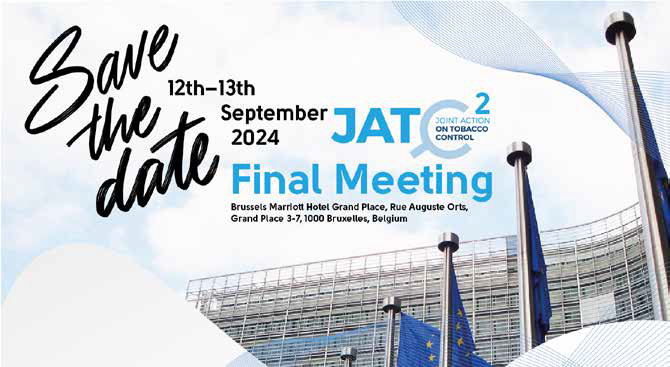
| Day 1, 12th September 2024 | |
|---|---|
| 13:30-14:10 | Welcome from the Coordinating Team Frances O’Donovan (MoH, Denmark) Welcoming Remarks • Sascha Maria Noomi Löwenstein, Senior Advisor in the Department of International Affairs, The Ministry of Interior and Health of Denmark • Angela Ciobanu, Τechnical Officer Tobacco Control, WHO Regional Office for Europe • Marc Vandenbroeck, Project Officer, HaDEA, European Commission • Artur Furtado, Head of Unit, Disease Prevention and Health Promotion, DG Health and Food Safety, European Commission |
| 14:10-14:30 | WP1 Coordination of the JATC-2 Presenter: Frances O’Donovan (MoH, Denmark) |
| 14:30-14:40 | Introductory Keynote on Tobacco Advertising, Promotion, and Sponsorship (TAPS) and Smoke-Free Environments Guest Speaker: Armando Peruga (IDIBELL, Spain) |
| 14:40-15:10 | WP8 Smoke-Free Environments and Tobacco Advertising, Promotion, and Sponsorship (TAPS) Legislation In Europe Moderators: Dolors Carnicer Pont (ICO, Spain) & Anna Mar López Luque (ICO, Spain) |
| 15:10-15:40 | Coffee Break and Networking |
| 15:40-15:50 | Introductory Keynote on E-cigarettes and Heated Tobacco Products (HTPs) Guest Speaker: Filippos Filippidis (European Respiratory Society – ERS) |
| 15:50-16:20 | WP7 Health Impact and Regulatory Implications of E-cigarettes and Novel Tobacco Products Moderators: Anne Havermans (RIVM, Netherlands) & Charlotte Pauwels (RIVM, Netherlands) |
| 16:20-16:40 | WP3 Evaluation of the JATC 2 Moderators: Irina Gebetsberger-Hartleitner (AGES, Austria) & Christine Weber (AGES, Austria) |
| 16:40-17:00 | Day 1 Synopsis and Wrap-up Moderators: Frances O’Donovan (MoH, Denmark) & Constantine Vardavas (NPHO, Greece) |
| 19:00-21:00 | Social Event – Dinner |
| Day 2, 13th September 2024 | |
|---|---|
| 09:00-09:30 | Arrival and Welcome Coffee |
| 09:30-09:40 | Introductory Keynote on Tobacco Product Regulation Guest Speaker: Luke Clancy (TobaccoFree Research Institute, Ireland) |
| 09:40-10:10 | WP6 Enforcement of Tobacco Product Regulation Moderators: Marie Østergaard Hejselbæk (DSTA, Denmark) & Monika Margrethe Nordborg (DSTA, Denmark) |
| 10:10-10:40 | Coffee Break and Networking |
| 10:40-10:50 | Introductory Keynote on Laboratories and Data for Tobacco Product Regulation Guest Speaker: Reinskje Talhout (RIVM, Netherlands) |
| 10:50-11:20 | WP5 European Union Common Entry Gate (EU-CEG) Data and Enhanced Laboratory Capacity For Regulatory Purposes Moderators: Benoît Labarbe (ANSES, France) & Enrico Davoli (IRCCS, Italy) |
| 11:20-11:30 | Introductory Keynote on Tobacco Industry Interference and Tricks Guest Speaker: Allen Gallagher (University of Bath, UK) |
| 11:30-11:50 | WP2 Dissemination of the JATC2 Moderators: Angeliki Lambrou (NPHO, Greece) & Iro Schoretsaniti (NPHO, Greece) |
| 11:50-12:00 | Introductory Keynote on Cross EU Cooperation Guest Speaker: Cornel Radu Loghin (European Network on Smoking and Tobacco Prevention – ENSP) |
| 12:00-12:30 | WP4 Sustainability and Cooperation Across Europe Moderators: Renata Solimini (ISS, Italy) & Maurice Mulcahy (HSE, Ireland) |
| 12:30-13:30 | Lunch Break |
| 13:30-13:40 | Introductory Keynote on Endgame for Tobacco Control Guest Speaker: Laurent Huber (Action on Smoking and Health – ASH USA) |
| 13:40-14:10 | WP9 Best Practices to Develop an Effective and Comprehensive Tobacco Endgame Strategy Moderators: Hanna Ollila (THL, Finland) & Helena Koprivnikar (NIJZ, Slovenia) |
| 14:10-15:00 | JATC2 Closing Session – Next Steps in Tobacco Control in Europe Moderators: Frances O’Donovan (MoH, Denmark) & Constantine Vardavas (NPHO, Greece) Commentary by: Panagiotis Behrakis (Lead Coordinator of JATC1), Armando Peruga (IDIBELL, Spain), Filippos Filippidis (ERS), Reinskje Talhout (RIVM, Netherlands), Luke Clancy (TFRI, Ireland), Allen Gallagher (University of Bath, UK), Cornel Radu-Loghin (ENSP), Laurent Huber (ASH, USA) |
| Closing Remarks | |
NEW PUBLICATIONS
Over the past months we have a few more publications on JATC2 work:
Solimini, Hanna Ollila, Silvano Gallus, Anne Havermans, Reinskje Talhout, Biljana Kilibarda, Milena Vasic, Esteve Fernández, Dolors Carnicer- Pont, Anna Mar Lopez, Eva M. Pérez-Sacristán, Zsuzsa Cselko, Maurice Mulcahy, Frances O’Donovan-Sadat. Tobacco Prevention & Cessation. 2024;10(May):21. doi:10.18332/tpc/188094.
An editorial in Tobacco Prevention & Cessation was recently published that highlighted the challenges posed by the tobacco industry (TI) and the need for protective measures. The TI continues to oppose effective policies and programs that reduce tobacco smoking and undermine tobacco control measures, influencing scientific research, politics, law, education, and the media.
This editorial aimed to support the implementation of Article 5.3 and its guidelines unanimously adopted by the Conference of the Parties of the WHO FCTC in 2008 [decision FCTC/COP3(7)], which is one of the most important cross-cutting provisions of the Convention, requiring Parties to protect their tobacco/nicotine control and public health policies from commercial and other vested interests of the TI.
The free full text of the Editorial is available for download here: https://doi.org/10.18332/tpc/188094
Tobacco endgame goals and measures in Europe: current status and future directions. Hanna Ollila, Otto Ruokolainen, Tiina Laatikainen, Helena Koprivnikar; and JATC-2 WP9 coauthors. Tob Control 2024 Jun 17:tc-2024-058606.
ABSTRACT
The European Union (EU) aims for a tobacco use prevalence of less than 5% by 2040 with its Tobacco- Free Generation goal, aligning with the tobacco endgame approach. In the Joint Action on Tobacco Control 2 (JATC-2) -project, we examined adopted and planned endgame goals and measures as well as preparedness to counter tobacco industry interference in the process. We surveyed key informants in 24 out of 50 countries in the WHO European Region (19 of the 27 EU Member States, MS). Altogether, eight countries (7 EU MS) had official governmental endgame goals, and an additional six EU MS had similar proposals from government, civil society or research entities. Movement towards tobacco endgame was most evident in retail-oriented and consumer-oriented policies. These include restricting the sales of tobacco and related products and raising the age limit above 18 years. Product standards were used especially to regulate flavours but no measures to substantially reduce addictiveness were reported. Market-oriented measures that tap into industry profits were predominantly missing, and countries often lacked concrete tools to prevent industry interference. Respondents’ concerns around tobacco endgame were related to high smoking prevalence in some population groups, non-combustible and new nicotine products, cross-border marketing, political will, challenges with the existing regulations and industry interference. Results indicate both momentum and challenges in adopting and disseminating measures that facilitate achieving tobacco endgame goals. The EU goal can be used to advocate for national endgame goals and measures, and for the strengthened implementation of the WHO Framework Convention on Tobacco Control.
The full text of the manuscript is available for download here: Tobacco endgame goals and measures in Europe: current status and future directions.
Urgent health concerns: Clinical issues associated with accidental ingestion of new metal-bladecontaining sticks for heated tobacco products. Paola Angela Moro, Francesca Maida, Renata Solimini, Lorenzo Spizzichino, Charlotte Pauwels, Elke Pieper, Anne Havermans. Tobacco Prevention & Cessation. 2024;10(July):31. doi:10.18332/tpc/190634.
ABSTRACT
Introduction: Recently, a concerning pattern has emerged in clinical settings, drawing attention to the potential health risks associated with the accidental ingestion, mostly by children, of a new Heated Tobacco Product (HTP) stick, which contains a sharp metal blade inside.
Material and Methods: Following a webinar of the Joint Action on Tobacco Control 2 project, where data on adverse health incidents related to novel tobacco and nicotine products from EU Member States were presented, the Milan Poison Control Center (PCC) conducted a case series study on the accidental ingestion of blade containing HTP sticks in Italy, between July 2023 and February 2024. The data in the medical records were analyzed to identify the age distribution, clinical presentation
symptoms, performed diagnostic procedures, and medical management.
Results: Overall, 40 cases of accidental ingestion of HTP sticks were identified and are described. A total of 33 (82.5%) children (infants and toddlers, mean age 12.3 ± 3.3 months) were hospitalized. Of these, 29 underwent abdominal X-rays, two children underwent esophagogastroduodenoscopy, and one child suffered from cut injuries to the tonsillar pillar and genian mucosa, requiring anesthesia for fibroscopy. The observed clinical cases associated with new HTP sticks containing a metal blade
occurred over just eight months. This issue required the immediate implementation of corrective measures to mitigate health risks. The Ministry of Health issued an alert regarding the dangers related to the accidental ingestion of the stick and imposed more visible warnings on the package.
Conclusions: It is of the utmost importance to raise awareness among both the general public and medical practitioners to prevent further cases of accidental ingestion of HTP sticks by infants and toddlers, and ensure a prompt and informed response in emergency situations.
The free full text of the manuscript is available for download here: https://doi.org/10.18332/
Tobacco endgame measures and their adaptation in selected European countries: A narrative review synthesis
Otto Ruokolainen, Hanna Ollila, Tiina Laatikainen, Salla-Maaria Pätsi, Giulia Carrera, Giuseppe Gorini, Dolors Carnicer-Pont, Zsuzsa Cselkó, Romain Guignard, Maria Karekla, Biljana Kilibarda, Helena Koprivnikar, Angeliki Lambrou, Viêt Nguyen-Thanh, Efstathios Papachristou, Sotiria Schoretsaniti, Milena Vasic. Tob. Prev. Cessation 2024;10(April):18. DOI: https://doi.org/10.18332/tpc/186402
ABSTRACT
Due to the continued detrimental effects of tobacco use, a growing number of countries are embracing the idea of tobacco endgame, meaning ending the tobacco epidemic instead of controlling it. This narrative review aims to synthesize and update the evidence from earlier scientific reviews on effective tobacco endgame measures, as well as to assess their integration to current national strategies among European countries with official tobacco endgame goals. The synthesis of the prior scientific literature found most evidence on product-focused and some evidence for supply-focused policies. Little evidence was detected for user- and institutionalfocused measures. An update for the tobacco-free generation measure showed uncertainty in reducing smoking prevalence, especially for adolescents’ reactions to age-restrictive laws. All the countries that established a tobacco endgame strategy have included product standards in their measures, predominantly based on European Union regulations on conventional tobacco products, yet standards above this level and considering other products were also common. Cessation measures were given strong emphasis in strategies, yet none of the countries linked these to specific endgame measures. Despite commonly mentioning vulnerable groups, such as youth and pregnant women, adoption of measures to reduce tobacco use among these groups was scarce. Lastly, the decline in tobacco use seems to be modest, implying challenges in meeting the endgame goals. To meet these goals, European countries should reinforce the implementation of known effective tobacco control measures such as tax increases. Furthermore, new innovative strategies and measures to meet the objective of an endgame should be explored.
The full text of the manuscript is available for download here:

